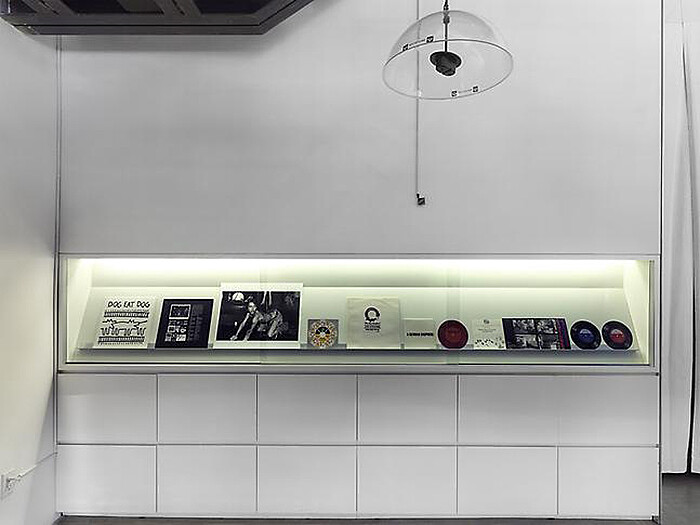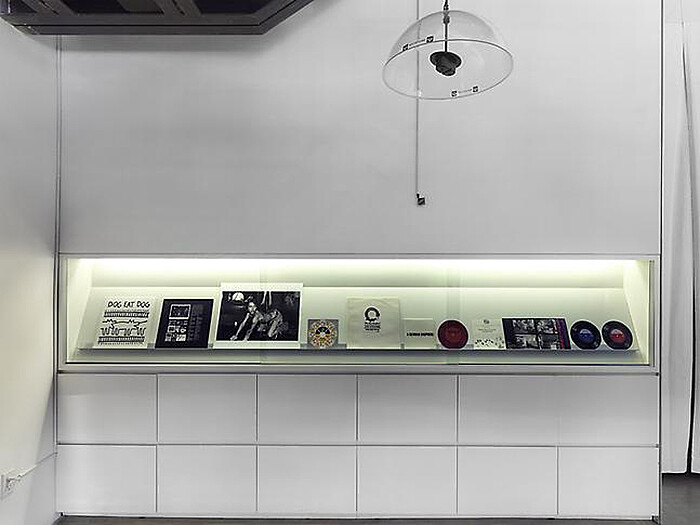Although dogs are “man’s best friend,” no other species has been as manipulated by humans—a strange take on friendship indeed. This tenuous power play between love and dominance lies at the heart of “Dogma,” Metro Pictures’s summer group show organized around the very relationships and allusions “forged between mankind and dogs” by Swiss Institute Director Gianni Jetzer.
And just to let you know who’s boss, Dustin Pittman’s NOW I WANT TO BE YOUR DOG, IGGY POP 1970 (1970), a black-and-white photograph of the singer wearing a studded collar while offering himself up on all fours, smacks the visitor on the nose upon entry. Joining this image are various other music-related references set in a shared vitrine, the strongest pairing of which is a Keith Haring band poster featuring a conga line of dogs biting other dogs’ asses next to the adage “DOG EAT DOG.” Slipping away from this scintillating juxtaposition of psycho-sexual innuendos are several record albums, namely, Cat Stevens’s Was Dog a Doughnut (1977), an early electro-dance track featuring barking dog sounds complimented by an image of a wiener dog-cum-ouroboros on it’s sleeve; a collection of sound effects edited by Jack Goldstein, most importantly the barks of German Shepherds; and an album from 1978 in which Dieter Roth and Richard Hamilton are joined by a dog-as-back-up-soul-singer, woof, woof!
Providing a kind of baseline to beat out further ideas of denigration and submission—the show’s de facto objective, as betrayed by the title’s homophonic pun—three of the galleries feature Valentin Carron’s Cercle archaïque mate (2011), a group of cast bronze shackles affixed to the wall, which could be used to tie up man or beast. Various other works tease out similar ideas as one finds Christopher Wool’s self-evident scolding with the words “BAD DOG” emblazoned on a large canvas (Untitled, 1992) in one gallery, while a wall stencil by Angela Bulloch (Doggy Run Association, 2012) lists the rules that dog owners themselves must obey when entering the park dog run: touché!
In any case, the idea of demands and commands is brought home best by Nina Beier’s Tragedy (2011), a performance in which an actual retriever repeatedly plays dead on a Persian carpet. So as to add a sense of the macabre—or melodrama depending on your perspective—to this feigned death ad absurdum, Jetzer has placed Andreas Slominski’s Dog Trap (2001), a metal container that could be used to actually ensnare and kill the play-actor when he wakes up. In any case, it is not the dog, but the luxury carpet that might be pulled from under us as the show continues.
Ivy and Poppy (2012), two neon silhouettes produced by the “readymade” artist Claire Fontaine—based on photographs of Metro Pictures owners’ small dogs—hang above the reception desk. Although these items might be for sale, collectors can also commission the artist to make new portraits of their own dogs for 20,000 Euro a pop. Cute as this may seem, the work’s underbelly could be that commissioned art, like a toy dog, is, at best, an accessory—or at worse, that such an artist might be a venerable lapdog to the rich. Such sentiments find an echo in the inclusion of Olaf Breuning’s hilarious Just Turn It and Make a Face on It (2008), a madly smiling graphite caricature of Jeff Koon’s Balloon Dog (1994), a multi-million dollar celebration of kitsch-as-luxury object.
Parody and farce is harped on once again in Jennifer Allora & Guillermo Calzadilla’s How to Appear Invisible (2009), a film in which a KFC chicken bucket—read as symbol of the global dominance of American Culture—collars and yokes a German Shepherd rummaging through the ruins of Berlin’s demolished Palast der Republik, the former East German Parliament Building that went into disuse after the fall of the GDR / Soviet Empire. Even though this work has very little to do with dogs as such, other than as metaphoric stand-in, the work plays a nice counterpoint to another neon work by Claire Fontaine installed on the facade of the gallery. Here, the group wrote out Kultur ist ein Palast der aus Hundescheiße gebaut ist (Culture is a Palace Built of Dog Shit), a Bertolt Brecht saying made famous in cultural critic Theodor W. Adorno’s tome Negative Dialectics—in which Adorno used the quip as a catch phrase to lament the decline of post-WWII European culture in the face of American commercialism. With these moves, the show’s narrative arc traces a nice bow turning from genuflection and regulation toward repression and the “return,” through cynicism, of those repressions in snarky critiques; however, these plot twists go astray as the curator doggedly tries to turn some more tricks.
For example, the show includes Lara Favaretto’s BJA (2010), an immensely seductive work in which a golden whistle hangs, just out of reach, from the ceiling on a golden chain. Within the context of this show, one might think that this device is yet another designer knickknack, or play thing for those in power to summon their dogs, or employees, or other subordinates, or whatever. And yet, the titular BJA stands for Bas Jan Ader, an artist who lost his life at sea, and as such, the set-up becomes a mythic and receding necessity just beyond our grasps. With a stretch, one could say this SOS might point to the use, or misuses, of Ader as a reference marshaled after his death by contemporary artists and art historians, but in any case, this forced pun anesthetizes the poetry of the work. Likewise, several other works take the idea of the “dog” too literally—maybe as another ruling order?—such as in Gray Hairs (1976), a looped close-up of William Wegman’s Weimeraner’s fur, or various paintings that include images of dogs linked to crass one-liners as in Sebastian Black’s Puppy Painting (la patte) (2012), wherein a geometric abstraction of a dog hides a secret peep at things like, gasp, pubic hair—you dog! Tryingly, Mungo Thomson’s Negative Space (STScl-PRC2012-01a) (2012) is asked to jump through the most hoops to run this course.
Here, the artist’s photoshopped negative of the center of the Tarantula—never mind that that is a spider—Nebula taken by the Hubble Space Telescope is asked to play a game of sliding signifiers. Let me explain: these stars might refer to another star, Sirius, which itself carries the sobriquet “Dog Star”—due to the fact that it is the most prominent star in the constellation Canius Major (Large Dog). But this game of fetch isn’t done yet. In antiquity—the relative position of the Earth to various stars has shifted over the last few thousand years due to the slight wobble of its own transit through space. Sirius, you see, used to rise over the horizon just before the sun would around late July and would continue to hang there till about late August, or roughly the period we call the late summer—in the Northern Hemisphere, of course. This signal, as it were, led the Romans to refer to this period of sultry weather as the “dog days,” a phrase still in use today. This factoid and its related mythology is mentioned in the press release as a nice anecdote to the fact that “Dogma” is a summer show running from late June to early August. Clever as this may be, Negative Space (STScl-PRC2012-01a), and its concerns with how digital technologies can stare into the “voids” of deep space, might not be the best illustration.
Like the records included at the entrance, these subplots, and there are a few more, should either be edited out or refined to a greater degree—after all, the Claire Fontaine, Christopher Wool, Angela Bulloch, etc., pack don’t really operate on any greater level of nuance than, say, Black’s paintings, however, their consort with each other is what makes them best-in-show.
Although a very near prizewinner, these loose tangents reveal that “Dogma” is really just a lovable mutt. And yet, with all the blue-chip work by established artists—Kippenberger, Trockel, Steinbach also fill out the gallery—the show doesn’t go wild enough to be a fierce and contentious mongrel despite its slightly political bark.







